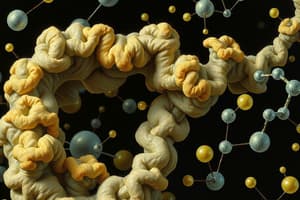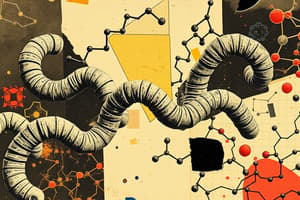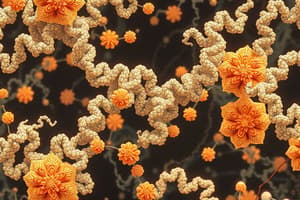Podcast
Questions and Answers
What is elastin?
What is elastin?
An insoluble protein polymer synthesized from a precursor, tropoelastin.
What is the amino acid structure of elastin primarily composed of?
What is the amino acid structure of elastin primarily composed of?
- Phenylalanine, Serine, Threonine
- Glycine, Alanine, Valine (correct)
- Methionine, Cysteine, Glutamic Acid
- Lysine, Proline, Asparagine
What is desmosine?
What is desmosine?
A unique cross-link in elastin made of four Lysine residues connected through their side chains.
What are some disorders associated with elastin?
What are some disorders associated with elastin?
What is the primary cause of emphysema?
What is the primary cause of emphysema?
What is Marfan Syndrome?
What is Marfan Syndrome?
What is Cutis Laxa?
What is Cutis Laxa?
What kind of proteins are integral membrane proteins?
What kind of proteins are integral membrane proteins?
What are glycoproteins?
What are glycoproteins?
What distinguishes ligases from other enzyme types?
What distinguishes ligases from other enzyme types?
What is the role of protein chaperones?
What is the role of protein chaperones?
What can cause protein denaturation?
What can cause protein denaturation?
What are prion diseases?
What are prion diseases?
What are amino acids?
What are amino acids?
What are proteins?
What are proteins?
What are proteins linked by?
What are proteins linked by?
What is a peptide?
What is a peptide?
What is a peptide bond?
What is a peptide bond?
What are electrostatic interactions?
What are electrostatic interactions?
What are dipole-dipole interactions?
What are dipole-dipole interactions?
What are hydrophobic interactions?
What are hydrophobic interactions?
What are covalent interactions?
What are covalent interactions?
What are the small amino acids?
What are the small amino acids?
What are the branched-chain amino acids?
What are the branched-chain amino acids?
What are the hydroxyl amino acids?
What are the hydroxyl amino acids?
What are the sulfur amino acids?
What are the sulfur amino acids?
What are the aromatic amino acids?
What are the aromatic amino acids?
What are the acidic amino acids?
What are the acidic amino acids?
What are the basic amino acids?
What are the basic amino acids?
Explain Proline.
Explain Proline.
What is sickle-cell anemia?
What is sickle-cell anemia?
Explain normal Hemoglobin.
Explain normal Hemoglobin.
Explain Sickle Cell Hemoglobin.
Explain Sickle Cell Hemoglobin.
Explain the Clinical Diagnosis.
Explain the Clinical Diagnosis.
What are protein functions?
What are protein functions?
What is the primary structure of a protein?
What is the primary structure of a protein?
What is the secondary structure of a protein?
What is the secondary structure of a protein?
What are supersecondary structures?
What are supersecondary structures?
What is the tertiary structure?
What is the tertiary structure?
How many interactions are needed for tertiary structure?
How many interactions are needed for tertiary structure?
What is the quaternary structure of a protein?
What is the quaternary structure of a protein?
How many interactions are needed for quaternary structure?
How many interactions are needed for quaternary structure?
When is a protein soluble?
When is a protein soluble?
When is a protein classified as a membrane protein?
When is a protein classified as a membrane protein?
What is a homoprotein?
What is a homoprotein?
What are heteroproteins?
What are heteroproteins?
What are fibrous proteins?
What are fibrous proteins?
What are globular proteins?
What are globular proteins?
Name the fibrous proteins.
Name the fibrous proteins.
What is Keratin?
What is Keratin?
What are the two types of Keratin deficiencies?
What are the two types of Keratin deficiencies?
What is Collagen?
What is Collagen?
Explain Collagen.
Explain Collagen.
What is the nascent peptide?
What is the nascent peptide?
How does Hydroxyproline stabilize collagen?
How does Hydroxyproline stabilize collagen?
What is Tropocollagen?
What is Tropocollagen?
What are collagen fibrils?
What are collagen fibrils?
What is extensive hydrogen bonding?
What is extensive hydrogen bonding?
What is needed for proper collagen formation?
What is needed for proper collagen formation?
What is Scurvy?
What is Scurvy?
What is Ehlers-Danlos syndrome?
What is Ehlers-Danlos syndrome?
What is Osteogenesis imperfecta?
What is Osteogenesis imperfecta?
What are the four different types of Osteogenesis imperfecta?
What are the four different types of Osteogenesis imperfecta?
What are the symptoms of Osteogenesis imperfecta?
What are the symptoms of Osteogenesis imperfecta?
What is Elastin?
What is Elastin?
Flashcards are hidden until you start studying
Study Notes
Amino Acids
- Over 300 amino acids exist in nature; only 20 are used in mammalian proteins.
- Amino acids classified by side chains into categories: Small, Branched-chain, Hydroxy, Sulfur, Aromatic, Acidic, and Basic.
Proteins
- Serve as structural and functional polymers in living organisms.
- Involved in energy usage, nerve transmission, muscle contraction, blood clotting, immune defense, and transport of vital substances.
- All proteins feature an N-terminal with a free amine group and a C-terminal with a free carboxyl group.
Peptides and Bonds
- Peptides are short chains of amino acids (2 to 50).
- Peptide bonds form covalent amide bonds between the carboxyl group of one amino acid and the amino group of another, making proteins water-soluble.
Interactions in Proteins
- Electrostatic interactions attract oppositely charged side chains while repelling like charges.
- Dipole-Dipole interactions or hydrogen bonds involve sharing of hydrogen ions between side chains.
- Hydrophobic interactions occur as hydrophobic amino acids cluster in the interior of globular proteins, excluding water.
Types of Amino Acids
- Small amino acids: Glycine and Alanine, found where polypeptide chains are close.
- Branched-chain amino acids: Valine, Leucine, Isoleucine with hydrophobic properties.
- Hydroxyl amino acids: Serine and Threonine, capable of forming hydrogen or covalent bonds with sugars and phosphates.
- Sulfur amino acids: Cysteine and Methionine; cysteine can form disulfide bonds to stabilize protein structure.
- Aromatic amino acids: Phenylalanine, Tyrosine, and Tryptophan; they can form hydrogen bonds and are generally hydrophobic.
- Acidic amino acids: Glutamate and Aspartate, negatively charged at physiological pH, important for forming strong hydrogen bonds.
- Basic amino acids: Lysine, Arginine, and Histidine, which carry a positive charge.
Unique Amino Acids
- Proline has a ring structure, affects flexibility, and is typically found at bends in polypeptides.
- Sickle-cell anemia occurs when valine replaces glutamate in hemoglobin, producing distorted red blood cells.
Hemoglobin Structures
- Normal hemoglobin consists of four subunits (2α and 2β chains).
- Sickle Cell hemoglobin can polymerize under low oxygen conditions, leading to sickle-shaped cells, which cause severe anemia.
Protein Functions
- Protein functions include binding, cellular structure, enzymatic catalysis, mechanical support, regulation, storage, and transport.
- Structure determines protein functionality.
Protein Structures
- Primary structure refers to the amino acid sequence.
- Secondary structure includes α-helices and β-sheets, stabilized by hydrogen bonds.
- Tertiary structure is the overall 3D conformation influenced by several types of interactions (electrostatic, hydrogen bonds, hydrophobic, and disulfide bonds).
- Quaternary structure involves multiple polypeptide chains organized through non-covalent interactions.
Protein Solubility
- Proteins are soluble when polar amino acids are on the surface and membrane proteins when nonpolar amino acids are exposed.
Protein Classification
- Homoproteins contain only amino acids; heteroproteins include non-protein prosthetic groups.
- Fibrous proteins (e.g., Keratin, Collagen, Elastin) provide structural support and are water-insoluble.
- Globular proteins (e.g., myoglobin) are generally water-soluble and perform metabolic functions.
Keratin
- A fibrous protein, primarily makes up skin appendages like hair and nails.
- Exists in two forms: α-keratin (in mammals) and β-keratin (in birds).
Collagen
- Most abundant protein in the extracellular matrix, vital for connective tissue strength.
- Composed of triple helices that form fibrils through covalent cross-linking.
Collagen Disorders and Deficiencies
- Scurvy, resulting from vitamin C deficiency, impairs collagen cross-linking leading to weakened connective tissues.
- Ehlers-Danlos syndrome results from collagen synthesis defects, leading to stretchy skin and fragile joints.
- Osteogenesis imperfecta is known for fragile bones due to mutations in collagen.
Elastin
- A highly stretchable protein found in connective tissues, allowing tissues to regain shape after stretching.
- Deficiencies or mutations can lead to disorders like Marfan Syndrome and α1-antitrypsin deficiency, leading to emphysema.
Testing and Diagnosis
- Clinical diagnosis can involve measuring free amino acids in urine and plasma to detect metabolic abnormalities.### Marfan's Syndrome
- Marfan's syndrome is characterized by tall stature, elongated limbs, and long thin fingers.
- Affects multiple organ systems including the eyes, heart, blood vessels, and skeleton.
- Major complication includes heart valve and aortic defects which can lead to life-threatening ruptures.
- Strenuous activities can exacerbate aortic aneurysms and lead to joint or lens injuries.
Cutis Laxa (CL)
- Cutis laxa is a rare connective tissue disorder resulting in loose and inelastic skin.
- Can be inherited or acquired and may develop due to inflammatory rashes or spontaneously.
- Various inheritance patterns exist: autosomal dominant, autosomal recessive, and X-linked recessive.
- Associated with a mutation in the FBLN5 gene impairing elastogenesis, particularly in recessive forms.
Cell Membrane Proteins
- Integral membrane proteins penetrate the hydrophobic phospholipid bilayer, playing critical biological roles.
- Peripheral membrane proteins are loosely associated with membranes, often linked to integral proteins.
- Glycoproteins, sugar-coated proteins, are important for cell-cell recognition and interaction.
- Enzymes in the membrane facilitate chemical reactions essential for metabolism.
Functions of Cell Membrane Proteins
- Membrane proteins account for approximately 25% of all cellular proteins.
- Essential for cellular communication including transport of molecules, cell recognition, and communication.
- Active transport mechanisms (e.g., ATPase) use energy to move ions against concentration gradients.
Integral Membrane Proteins (Integrins)
- Integral membrane proteins are essential for membrane structure and function, interacting with the phospholipid bilayer.
- Typically removed from membranes only through strong detergents that disrupt hydrophobic interactions.
- They include hormone receptors, ion channels, and transporters pivotal for cellular functions.
Examples of Integrins
- Include hormone receptors, transporters like Na+ - K+ ATPase, and various enzymes.
- Notable example: β-adrenergic receptor spans the membrane seven times, indicating its integral role in signaling.
Membrane Transporters
- Comprise proteins with transmembrane domains that facilitate both active and passive transport of substances across membranes.
- Active transport involves energy use (e.g., Na-K ATPase), while passive transport relies on diffusion.
ABC Transporters
- Largest family of transporters, crucial for nutrient uptake, drug excretion, and cellular functions.
- Utilize ATP hydrolysis for the transport of substrates across cellular membranes.
- Key features include ATP Binding domains and transmembrane domains formed by alpha helices.
Peripheral Membrane Proteins
- Loosely associated with cell membranes and typically attached to integral proteins.
- Example: Cytochrome C in the electron transport chain.
Glycoproteins
- Proteins covalently bonded to oligosaccharides, significant for cell surface recognition and interaction.
- Key roles in antigenicity, membrane receptor function, and extracellular matrix components.
Key Enzymes Classification
- Oxidoreductases: Transfer electrons between molecules.
- Transferases: Move functional groups between molecules.
- Isomerases: Rearrange molecular structures.
- Lyases: Add or remove atoms from double bonds.
- Ligases: Form bonds using ATP hydrolysis.
- Hydrolases: Cleave bonds through water addition.
Glutathione
- A critical tri-peptide composed of Glu, Cys, and Gly, playing roles in protein synthesis and antioxidant defenses.
- Protects cells from oxidative stress and facilitates amino acid transport across membranes.
Protein Misfolding
- Errors in protein folding can lead to diseases, caused either by spontaneous folding mistakes or genetic mutations.
- Misfolded proteins are often tagged for degradation, impacting bodily functions.
Diseases Linked to Protein Misfolding
- Examples include cystic fibrosis (misfolded CFTR), Marfan syndrome (misfolded fibrillin), and various cancers linked to tumor suppressor protein misfolding.
- Protein aggregation disorders include Alzheimer's, Parkinson's, and spongiform encephalopathies.
Amyloidoses
- Defined by abnormal fibrillar protein formation, primarily β-pleated sheets.
- Result in insoluble amyloid deposits affecting tissue function.
Prion Diseases
- Caused by infectious prion proteins leading to transmissible spongiform encephalopathies (TSEs) such as Creutzfeldt-Jakob disease.
- These diseases are characterized by insoluble fibril aggregation, causing severe neurodegeneration.
Studying That Suits You
Use AI to generate personalized quizzes and flashcards to suit your learning preferences.





